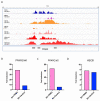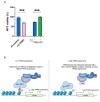TRIB3 Modulates PPARγ-Mediated Growth Inhibition by Interfering with the MLL Complex in Breast Cancer Cells
- PMID: 36142452
- PMCID: PMC9503934
- DOI: 10.3390/ijms231810535
TRIB3 Modulates PPARγ-Mediated Growth Inhibition by Interfering with the MLL Complex in Breast Cancer Cells
Abstract
Aberrant expression or activity of proteins are amongst the best understood mechanisms that can drive cancer initiation and progression, as well as therapy resistance. TRIB3, a member of the Tribbles family of pseudokinases, is often dysregulated in cancer and has been associated with breast cancer initiation and metastasis formation. However, the underlying mechanisms by which TRIB3 contributes to these events are unclear. In this study, we demonstrate that TRIB3 regulates the expression of PPARγ, a transcription factor that has gained attention as a potential drug target in breast cancer for its antiproliferative actions. Proteomics and phosphoproteomics analyses together with classical biochemical assays indicate that TRIB3 interferes with the MLL complex and reduces MLL-mediated H3K4 trimethylation of the PPARG locus, thereby reducing PPARγ mRNA expression. Consequently, the overexpression of TRIB3 blunts the antiproliferative effect of PPARγ ligands in breast cancer cells, while reduced TRIB3 expression gives the opposite effect. In conclusion, our data implicate TRIB3 in epigenetic gene regulation and suggest that expression levels of this pseudokinase may serve as a predictor of successful experimental treatments with PPARγ ligands in breast cancer.
Keywords: MLL–WRAD complex; PPARγ; Tribbles; breast cancer; epigenetics.
Conflict of interest statement
The authors declare no conflict of interest.
Figures






References
MeSH terms
Substances
Grants and funding
LinkOut - more resources
Full Text Sources
Medical
Molecular Biology Databases

